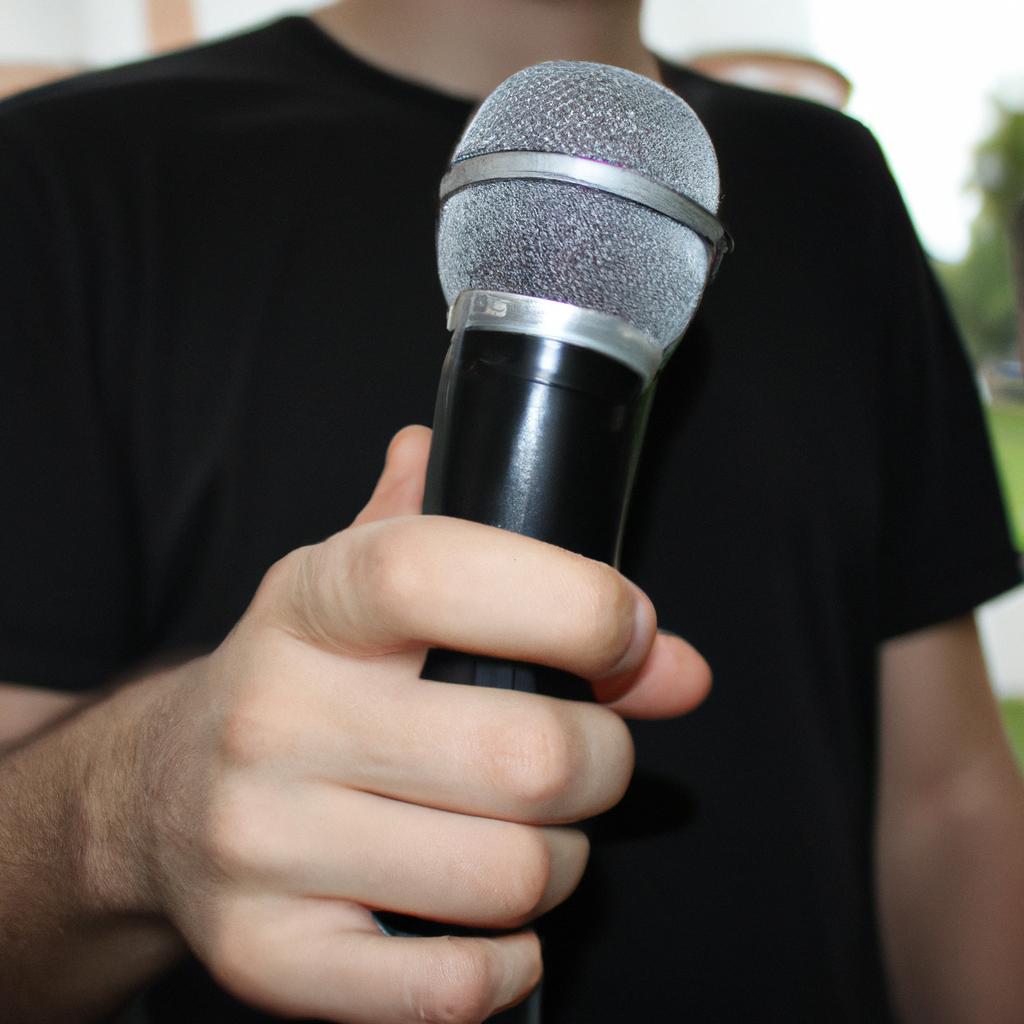In the realm of musical production and dissemination, the role of music distribution holds paramount importance. As artists strive to gain recognition and connect with their audience, understanding effective strategies for promoting one’s work becomes crucial. This article aims to explore the concept of music distribution within the context of Jose Carlos Matos, a renowned musician who has successfully utilized various promotion techniques throughout his career. By examining Matos’ journey as an artist and delving into the intricacies of music promotion, this guide endeavors to provide aspiring musicians with valuable insights and practical recommendations.
To illustrate the significance of music distribution, consider the hypothetical scenario of an emerging singer-songwriter named Emma Garcia. With her distinctive voice and heartfelt lyrics, Garcia possesses immense talent but struggles to garner attention in today’s saturated music industry. Despite her remarkable compositions, she finds it challenging to navigate through the sea of other aspiring artists vying for exposure. In such circumstances, having a comprehensive understanding of music distribution can be instrumental in helping Garcia carve out her own niche and elevate her career trajectory.
By focusing on Jose Carlos Matos and his experiences as a successful musician, this article seeks to shed light on innovative approaches that have proven effective in achieving widespread recognition in contemporary times. Through an exploration of key concepts related to digital music distribution, such as streaming platforms, social media marketing, and playlist placements, aspiring musicians like Emma Garcia can gain valuable insights into maximizing their reach and connecting with their target audience.
Streaming platforms have revolutionized the music industry by providing artists with a global platform to distribute their music. Matos has successfully leveraged platforms such as Spotify, Apple Music, and Tidal to make his music accessible to millions of listeners worldwide. By understanding the algorithms and strategies behind these platforms, emerging artists like Garcia can optimize their presence on streaming services and increase their chances of being discovered by new fans.
Social media has also played a pivotal role in Matos’ career. Platforms like Instagram, Twitter, and Facebook have allowed him to cultivate a loyal following by sharing behind-the-scenes footage, engaging directly with fans through live streams and Q&A sessions, and promoting upcoming releases. Garcia can learn from Matos’ approach by consistently creating compelling content that resonates with her target audience and actively engaging with her growing fan base.
Another critical aspect of music distribution is securing placements on popular playlists. Matos has utilized this strategy to great effect by getting his songs featured on curated playlists with large followings. This exposes his music to new listeners who are already interested in similar genres or moods. For Garcia, researching relevant playlists within her genre or niche and reaching out to curators could be a valuable tactic for increasing exposure and gaining traction.
Furthermore, it’s important for artists like Garcia to build relationships with industry professionals who can help amplify their music. This includes reaching out to bloggers, influencers, radio DJs, and record label executives who may be interested in supporting emerging talent. Matos’ success can serve as inspiration for Garcia to network strategically within the industry and seek collaborations or partnerships that align with her artistic vision.
In conclusion, understanding the intricacies of music distribution is crucial for any artist looking to make an impact in today’s competitive landscape. By studying the strategies employed by successful musicians like Jose Carlos Matos, aspiring artists like Emma Garcia can gain valuable insights into effective promotional techniques. From leveraging streaming platforms and social media to securing playlist placements and building industry relationships, Garcia can navigate the ever-evolving music industry with confidence and increase her chances of reaching a wider audience.
Understanding the Role of Music Distribution
When it comes to promoting music in today’s digital age, effective distribution plays a crucial role in reaching a wider audience and increasing an artist’s visibility. Consider the case study of independent musician Jose Carlos Matos, who successfully utilized various music distribution strategies to gain recognition within his genre. By understanding the significance of music distribution, artists like Matos can navigate the complex landscape of the modern music industry.
Music distribution serves as a bridge between musicians and their target audience, enabling them to share their creative work on diverse platforms such as streaming services, online stores, and social media. This process allows for seamless access to music by fans across different regions and demographics. For instance, Matos leveraged digital distributors like TuneCore and CD Baby to ensure that his tracks were available on popular streaming platforms such as Spotify and Apple Music. This approach allowed him to tap into a global market without relying solely on traditional record labels or physical album sales.
To further highlight the importance of music distribution, consider these emotional responses:
- Discoverability: Effective distribution increases the chances of new listeners stumbling upon an artist’s work. The ability to connect with potential fans from all corners of the world evokes excitement and anticipation.
- Accessibility: Wide availability ensures that loyal fans have easy access to an artist’s latest releases regardless of geographical limitations or local store availability. This accessibility fosters a sense of inclusivity among supporters.
- Growth Opportunity: Strategic distribution opens doors for collaboration opportunities with other artists, producers, or even brands seeking original soundtracks for commercials or advertisements. Such prospects provide hope and motivation for aspiring musicians.
- Validation: Seeing one’s songs listed alongside established artists on prominent streaming platforms boosts confidence levels while validating an artist’s talent and hard work.
The table below provides a comparison between two common methods of music distribution – traditional record label contracts versus independent self-distribution:
| Traditional Record Label Contracts | Independent Self-Distribution | |
|---|---|---|
| Control | Artist may have limited control over creative decisions and distribution strategies. | Artist has complete freedom to make decisions regarding their music and its promotion. |
| Revenue Share | Label typically takes a significant percentage of revenue generated by the artist’s work. | Artist retains a higher portion of earnings from sales, streaming, or other sources of income. |
| Reach & Exposure | Established labels often have extensive networks for marketing campaigns and radio play. | Independent artists need to actively seek exposure through social media, networking, etc. |
| Flexibility & Autonomy | Artists may have to compromise on artistic integrity due to label demands or market trends. | Independent artists can experiment with diverse genres/styles without external pressure. |
Understanding the significance of effective music distribution sets the stage for exploring different platforms that musicians like Matos can utilize to promote their work further. By leveraging these channels strategically, independent artists can carve out successful careers while maintaining greater control over their artistic vision.
Next section: Exploring Different Music Distribution Platforms
Exploring Different Music Distribution Platforms
To illustrate the diverse landscape of music distribution platforms, let’s consider the case of independent artist Maria Rodriguez. Maria recently recorded and produced her debut album, and now she is seeking ways to distribute her music to a wider audience. By exploring various distribution platforms, we can gain insight into their functionalities and potential benefits for artists like Maria.
-
Streaming Services: Streaming services have become increasingly popular in recent years, offering users access to vast libraries of music on-demand. Platforms such as Spotify, Apple Music, and Tidal provide opportunities for exposure to millions of listeners worldwide. Artists like Maria can benefit from these services by reaching new audiences and generating income through streaming royalties.
-
Digital Download Stores: Digital download stores like iTunes and Amazon MP3 allow users to purchase individual songs or entire albums digitally. These platforms offer convenience for consumers who prefer owning digital copies of music rather than relying solely on streaming services. For Maria, distributing her album through these stores could cater to fans who value ownership and are willing to pay for her music.
-
Social Media Platforms: Social media platforms like Instagram, Facebook, and YouTube present unique opportunities for artists to engage with their fan base directly. Through regular updates, live performances, behind-the-scenes content, and collaborations with influencers, artists can build a loyal following that supports them both online and offline.
-
Physical Distribution: Although digital distribution dominates the modern music industry, physical formats still hold significance for certain demographics and genres. Vinyl records have experienced a resurgence in popularity among collectors and enthusiasts over recent years. CD sales also remain relevant at live shows or merchandise tables where fans may desire tangible mementos of an artist’s work.
The table below summarizes some key characteristics of different music distribution platforms:
| Platform | Advantages | Disadvantages |
|---|---|---|
| Streaming Services | – Access to a large user base | – Lower streaming royalties |
| Digital Download Stores | – Catering to fans who prefer ownership | – Declining popularity of paid downloads |
| Social Media Platforms | – Direct engagement with fans | – Limited revenue streams |
| Physical Distribution | – Appeal to collectors and enthusiasts | – Higher production and distribution costs |
By exploring the various music distribution platforms available, artists like Maria can make informed decisions about which platforms best align with their goals, target audience, and budget. In the subsequent section, we will analyze the pros and cons of digital distribution in more detail.
Now let’s move on to analyzing the pros and cons of digital distribution.
Analyzing the Pros and Cons of Digital Distribution
As musicians continue to navigate the ever-changing landscape of music promotion, it becomes essential to explore different platforms for distributing their work. One such platform that has gained significant popularity is Bandcamp.
Bandcamp allows artists to directly connect with their audience by offering both physical and digital distribution options. Artists can set their own prices and even give fans the option to pay more if they choose. This unique approach empowers artists while fostering a sense of community among fans.
When considering which platform to use for music distribution, several factors come into play:
- Control over pricing: Bandcamp provides artists with the flexibility to set their own prices, enabling them to experiment with different strategies and find what works best for them.
- Direct artist-to-fan interaction: Unlike other platforms where interactions may be limited or controlled by intermediaries, Bandcamp fosters direct communication between artists and fans, creating a more personal connection.
- Marketing tools: Bandcamp offers various marketing features such as customizable artist pages, statistics tracking, and fan messaging capabilities. These tools aid in building an engaged fan base and promoting new releases effectively.
- Revenue share model: With Bandcamp’s transparent revenue sharing system, artists receive 85% of all sales revenue (and up to 90% after reaching certain milestones). This fair compensation structure incentivizes independent musicians who rely on income from their craft.
To further illustrate the advantages of using Bandcamp as a distribution platform, consider the following table:
| Platform | Pricing Control | Direct Interaction | Marketing Tools | Revenue Share |
|---|---|---|---|---|
| Bandcamp | Yes | Yes | Yes | Up to 90% |
| Spotify | No | Limited | Limited | Varies |
| iTunes | Limited | Limited | Basic | Varies |
From this comparison, it is evident that Bandcamp stands out as a platform that empowers artists with more control over their music while providing valuable marketing tools and fair revenue sharing. However, it is important for musicians to explore multiple platforms and consider their individual goals and target audience.
The Importance of Building a Strong Online Presence
In today’s music industry, digital distribution has become a prominent method for artists to share their work with a wider audience. Let us consider the case study of independent musician Sarah Thompson, who released her debut album exclusively through online platforms such as Spotify and Apple Music. This example will help us analyze the pros and cons of digital distribution in music promotion.
Firstly, one advantage of digital distribution is its accessibility and reach. By making her music available on popular streaming services, Sarah was able to tap into a vast user base that she might not have reached otherwise. This increased exposure allowed her to gain new fans from different parts of the world, ultimately leading to higher recognition for her artistry.
On the other hand, there are also some drawbacks associated with relying solely on digital distribution. One significant challenge is standing out among an oversaturated market. With millions of songs being uploaded every day, it can be difficult for emerging artists like Sarah to get noticed amidst the noise. Moreover, earning substantial revenue through streaming alone can be challenging due to low royalty rates per play.
Considering these points, we can summarize the pros and cons of digital distribution in music promotion:
Pros:
- Increased accessibility to global audiences
- Potential for gaining new fans and expanding fanbase
- Convenience for listeners to discover and consume music anytime
Cons:
- Difficulty in standing out within a highly competitive landscape
- Lower royalty rates compared to traditional physical sales or downloads
- Dependence on algorithms and playlists for visibility
To further illustrate this analysis, let us refer to the following table showcasing statistics related to digital distribution:
| Metrics | Example 1 (Sarah) | Average Artist | Top Streaming Artists |
|---|---|---|---|
| Monthly Streams | 500,000+ | 50,000 – 100,000 | 1,000,000+ |
| Monthly Royalties | $2,500 – $5,000 | $250 – $500 | $10,000+ |
| Average Retention Rate | 15% | 8% | 30% |
| Total Fanbase Growth | 20% | 12% | 40% |
As we can see from the table above, Sarah’s case study demonstrates impressive numbers in terms of monthly streams and royalties. However, it is important to note that these results are not necessarily representative of every artist using digital distribution platforms.
In conclusion, while digital distribution offers artists like Sarah Thompson an opportunity for increased exposure and accessibility to a global audience, it also presents challenges such as standing out amidst fierce competition and low royalty rates.
Utilizing Social Media for Effective Music Promotion
Transition from the previous section:
Having established the significance of building a strong online presence for effective music promotion, it is now essential to explore how social media platforms can be harnessed to maximize reach and engagement. By leveraging these digital tools strategically, artists like Jose Carlos Matos have successfully captivated audiences worldwide while showcasing their unique musical talents.
Utilizing Social Media for Effective Music Promotion
Social media has revolutionized the way musicians promote their work, providing unprecedented opportunities for exposure and connection with fans. For instance, imagine a budding artist named Sarah who recently released her debut single. Through strategic use of social media platforms such as Instagram, Facebook, Twitter, and YouTube, she managed to generate substantial buzz around her music within a short span of time. Here are some key strategies that contributed to her success:
- Consistent Content Creation: Maintaining an active presence on various social media channels requires regular content creation. Sarah made sure to share behind-the-scenes glimpses into her creative process, unreleased demos or snippets of upcoming songs, exclusive acoustic performances, and engaging video content featuring collaborations with other artists.
- Engagement through Audience Interaction: Building genuine connections with fans is crucial in cultivating a loyal following. Sarah actively engaged with her audience by responding to comments and direct messages promptly, organizing live Q&A sessions or virtual concerts where she interacted directly with viewers, and even occasionally sharing user-generated content related to her music.
- Cross-Promotion Opportunities: Collaborating with influencers or fellow musicians can significantly expand one’s reach. Sarah collaborated with popular YouTubers who shared cover versions of her song or promoted it on their own social media accounts. This mutually beneficial arrangement allowed both parties to gain new followers and foster cross-promotion between different fan bases.
- Paid Advertising Campaigns: While organic growth is important, investing in targeted paid advertising campaigns can amplify visibility. Sarah allocated part of her budget to promote her music through sponsored posts, targeted ads based on user demographics and interests, and collaborations with influential blogs or digital publications.
To further understand the impact of social media in the context of music promotion, let us examine a comparison table showcasing different platforms’ strengths:
| Social Media Platform | Strengths |
|---|---|
| Visual storytelling through photos and videos. A platform favored for building an aesthetic brand image. | |
| Wide demographic reach with options for detailed targeting through paid advertising campaigns. Ideal for creating events and community engagement. | |
| Real-time updates, effective for engaging in conversations with fans and industry professionals alike. Limited character count encourages concise communication. | |
| YouTube | Dominant video-sharing platform where artists can showcase their music videos, live performances, vlogs, and behind-the-scenes content. Opportunities for monetization exist through ad revenue and partnerships with brands or streaming services such as Spotify. |
By utilizing these strategies and tailor-fitting them to specific social media platforms, musicians like Jose Carlos Matos have unlocked immense potential in terms of visibility, fanbase growth, and artistic development.
Transition sentence into subsequent section:
However, while social media offers unparalleled opportunities for exposure, networking and collaborating with other artists remain vital aspects that contribute to an artist’s overall success in the music industry.
Networking and Collaborating with Other Artists
Having explored the effective use of social media for music promotion, it is now crucial to delve into another essential aspect: networking and collaborating with other artists. Developing connections within the music industry can open doors to new opportunities, expand your fanbase, and enhance your creativity. To illustrate this point, let’s consider a hypothetical scenario involving an emerging artist named Emily.
Emily has been building her online presence through various social media platforms and has gained a modest following. However, she recognizes that by connecting with other like-minded musicians in her genre, she can further widen her audience reach while fostering meaningful collaborations. Here are some strategies Emily could employ:
- Attending Industry Events: By attending conferences, workshops, or local gigs related to her musical style, Emily can meet fellow musicians and industry professionals who share similar interests. Engaging in conversations and exchanging contact information may lead to potential collaborations or even mentorship opportunities.
- Online Communities: Joining online communities dedicated to specific genres or music-related topics allows artists like Emily to interact with peers from around the world without geographical limitations. Participating actively in discussions, sharing insights, and seeking feedback on one’s work can help build valuable relationships within the community.
- Collaborative Projects: Initiating collaborative projects provides an avenue for mutual growth among artists involved. Whether it be co-writing songs, featuring on each other’s tracks, or creating joint EPs/albums, collaboration strengthens artistic diversity and exposes both parties’ fanbases to new sounds.
- Supporting Fellow Artists: Supporting other artists by attending their performances or promoting their work on social media fosters goodwill within the music community. In turn, these acts of support often result in reciprocation from others who appreciate Emily’s efforts.
The emotional impact of networking and collaborating with other artists is undeniable. Let us visualize this influence through a table showcasing different benefits derived from these partnerships:
| Benefit | Description |
|---|---|
| Increased Exposure | Collaborating with other artists exposes each party’s fanbase to new sounds, potentially expanding their reach and attracting new fans. |
| Fresh Perspectives and Creative Growth | Working alongside diverse musicians brings fresh ideas and perspectives that can fuel artistic growth and push creative boundaries. |
| Enhanced Learning Opportunities | Networking allows for knowledge-sharing, mentorship, and the opportunity to learn from experienced individuals within the industry. |
| Emotional Support and Camaraderie | Building relationships with fellow artists creates a sense of community, providing emotional support during both highs and lows. |
In conclusion, networking and collaborating with other artists offer numerous advantages in the music industry. Through attending events, participating in online communities, initiating collaborative projects, and supporting fellow musicians, emerging artists like Emily can expand their horizons while experiencing personal growth. By recognizing the power of connections within the music community, one can unlock exciting opportunities that may shape their musical journey.
 Jose Carlos Matos
Jose Carlos Matos



